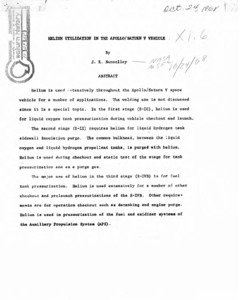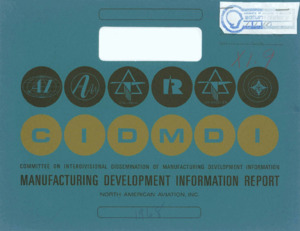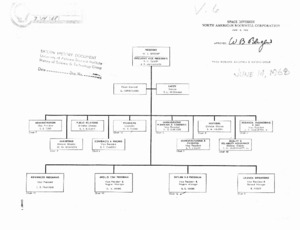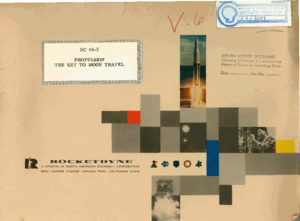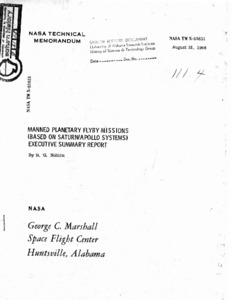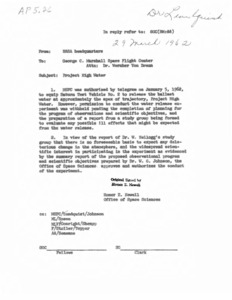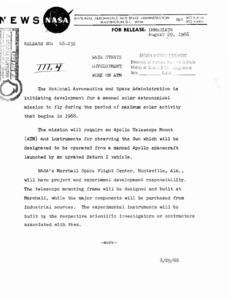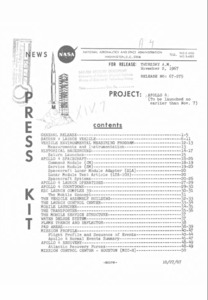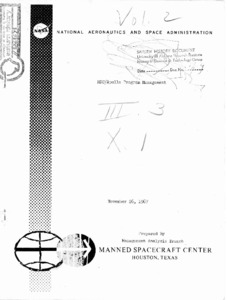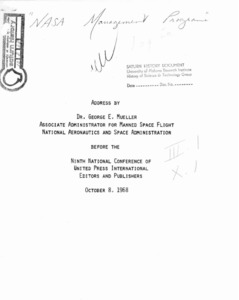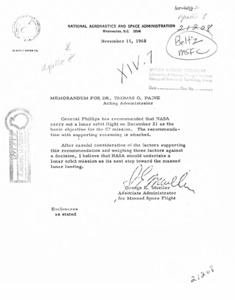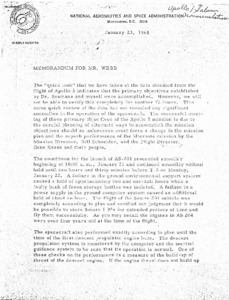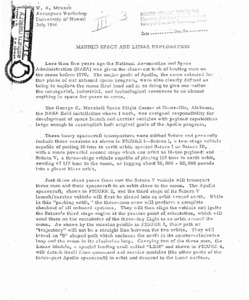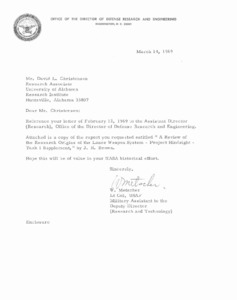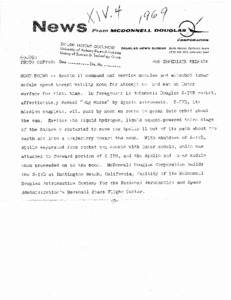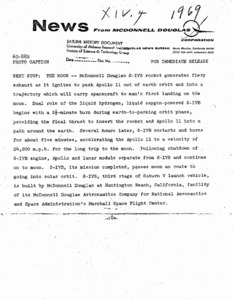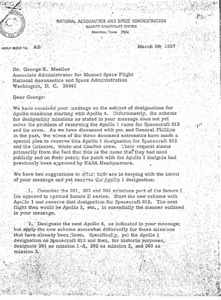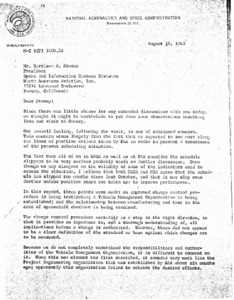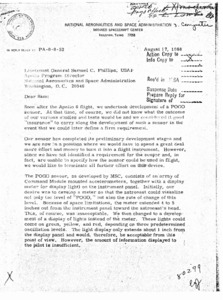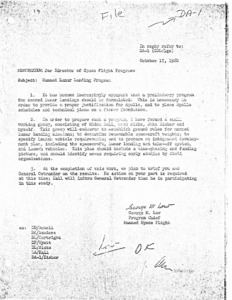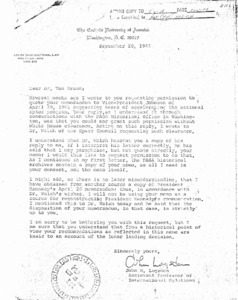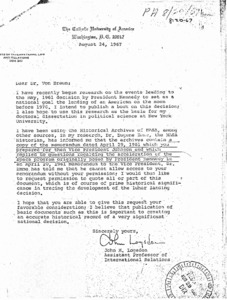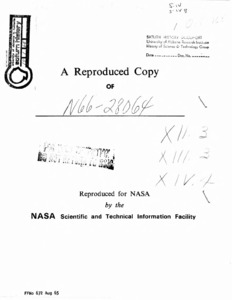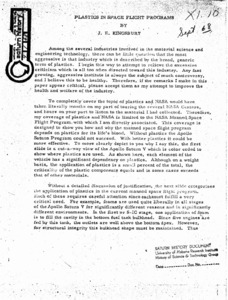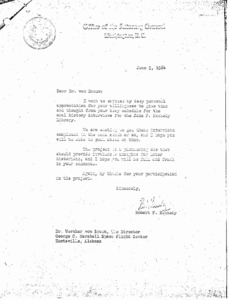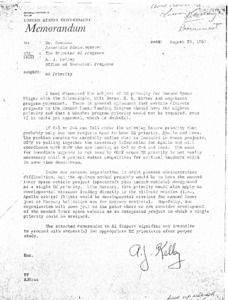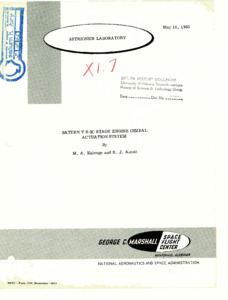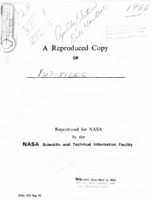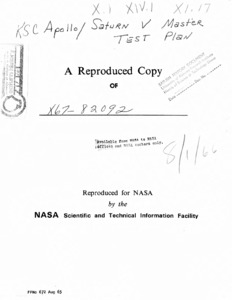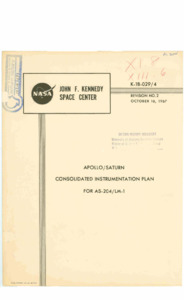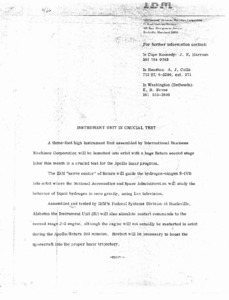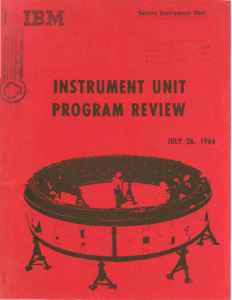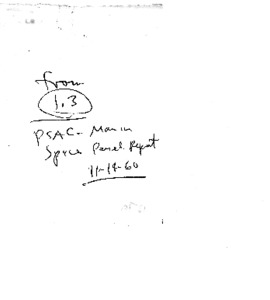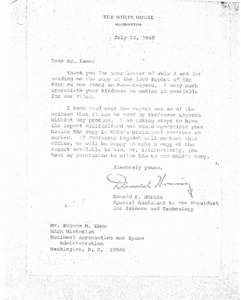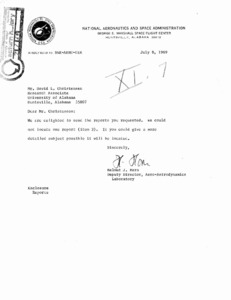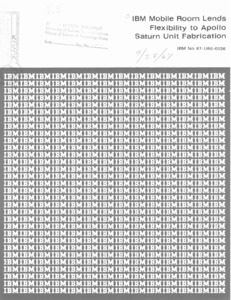
Browse Items (156 total)
Sort by:
-
"Helium Utilization in the Apollo/Saturn V Vehicle."
Helium is used extensively throughout the Apollo/Saturn V space vehicle for a number of applications. The welding use is not discussed since it is a special topic. In the first stage (S-IC), helium is used for liquid oxygen tank pressurization during vehicle checkout and launch. -
"Manufacturing Development Information Report."
The Committee on Interdivisional Dissemination of Manufacturing Development Information (CIDMDI) is comprised of NR - divisional representatives closely associated with advancement of the manufacturing arts . The purpose of the committee is to impart and receive development information of interest to NR manufacturing areas. Space Division's Central Manufacturing presents this CIDMDI Annual Report, for CFY 1968, in compliance with CIDMDI objectives. Included are research projects conducted by Central Manufacturing,as well as pertinent items submitted by the Apollo and Saturn Projects, for which, acknowledgement and appreciation are extended. Because of the large number of reports contained in this issue, only general information has been presented. Detailed data, if permissible, will be made available on request. For further information, contact L. B. Norwood, Space Division, Extension 1915.; PAP 68-0013.; Prepared by Advanced Projects Section of Central Manufacturing. L. B. Norwood, CIDMDI, Representative. F. H. Burry, Director, Manufacturing. -
"Space Division, North American Rockwell Corporation Organizational Chart."
Organization chart for North American Rockwell, 1968 -
"Propulsion : the key to moon travel."
Paper focusing on past and future moon missions. Contains graphics of rockets and modules -
"Manned planetary flyby missions (based on Saturn/Apollo Systems) : executive summary report."
This report summarizes a study (by North American Aviation, Space Division) of Manned Interplanetary Flyby Missions to Venus and Mars during the period from 1975 to 1982. [The study was a broad but penetrating technical investigation of using a manned flight system for planetary exploration.] The results, along with previously known aspects of manned Mars and Venus flyby missions, vehicles, and systems, were integrated into total mission-system capable of performing a realistic and meaningful planetary exploration program. Manned Planetary Missions are feasible. Attractive multiplanet flyby missions can be performed by Saturn/Apollo systems. However, injected payload and mission requirements developed within the guidelines and assumptions of this study cannot be met with modified S-II or S-IV stages when used with the standard Saturn V Earth-launch vehicle. When using an Earth orbit assembly mode and an uprated Saturn Earth launch vehicle for application to manned planetary flyby missions, the launch vehicle should have a payload capability (2-stage to low Earth orbit) of 400,000 pounds or more for use with M(S)-IVB planetary injection stages. Manned planetary flyby missions provide a means of combining the favorable aspects of both manned and unmanned missions into a unique and highly effective planetary exploration mission-system capable of providing major significant inputs to the scientific and engineering questions concerning the interplanetary medium, our Sun, and our neighboring planets Venus and Mars. -
"Project High Water."
Letter to Wernher von Braun from NASA headquarters regarding Project Highwater and how it was withheld. -
"Press release : NASA starts development on ATM."
Press release describing NASA's plans to begin manned missions set to begin in 1968. -
"Apollo 4 press kit."
The flrst flight test of the Apollo/Saturn V space vehicle is scheduled for launch from the Natlonal Aeronautics and Space Administration's John F, Kennedy Space Center, Fla., no earlier than Nov. 7. The mission is designated Apollo 4. -
"MSC/Apollo program management"
The purpose of this document is to describe how the Manned Spacecraft Center is managing its responsibilities in the Apollo Program The organization, procedures, and management philosophy described herein, represent the accumulated knowledge gained from our experience with the Mercury, Gemini, and Apollo Programs. It should be remembered, however, that managing a research and development program of Apollo's size and complexity, is an experimental "R&D" process in itself. -
"NASA management programs."
Address by Dr. George E. Mueller, Associate Administrator for Manned Space Flight, National Aeronautics and Space Administration before the Ninth National Conference of United Press International Editors and Publishers, October 8, 1968. -
"Memorandum for Dr. Thomas O. Paine, Acting Director from George E. Mueller, Associate Administrator for Manned Space Flight, dated November 11, 1968."
Memorandum containing a recommendation from General Phillips to continue with the lunar orbit flight scheduled for December. -
"Memorandum for Mr. Webb from George E. Mueller."
Memorandum discussing a review of the data of the Apollo 5 flight. -
"Manned space and lunar exploration."
Paper includes references to figures and NASA's fundamental goals and principles. -
"The Saturn launch vehicle family."
Presentation focusing on the history of Saturn V's engineering history and crew. -
"Letter from Mr. David L. Christensen."
Letter stating that "A review of the research origins of the Lance weapon system - Project Hindsight -Task 1 supplement" is inside as requested. -
"Moon-bound"
Press release describing a photograph of a lunar module. -
"Next stop : the moon."
Release describing the launch of the Apollo 11. -
"Letter to Dr. George E. Mueller."
This letter regarding designations for Apollo missions notes that "Unfortunately, the scheme for designating missions as stated in your message does not yet solve the problem of reserving the Apollo 1 name for Spacecraft 012 and its crew. As we have discussed with you and General Phillips in the past, the wives of the three deceased astronauts have made a special plea to reserve this Apollo 1 designation for Spacecraft 012 and the Grissom, White and Chaffee crew."; Archive copy is a photocopy.; In replay refer to: AB. -
"Letter to Mr. Harrison A. Storms."
Letter to Harrison A. Storms from George H. Lowe and Joseph F. Shea expressing concerns they have over the lack of positive actions taken by the NAA. -
"Letter to Lieutenant General Samuel C. Phillips."
Letter to Lieutenant General Samuel C. Phillips from George M. Lowe regarding what happened on the Apollo 6 flight. -
"Memorandum for Director of Space Flight Programs" related to the "Manned Lunar Landing Program."
Memorandum recommending formulating a "justification" for the Apollo project and and place schedules/plans on a "firmer foundation." -
"Letter to Dr. Wernher von Braun."
Letter to Wernher von Braun from John M. Logsdon reiterating his request to use Braun's memorandum in his book as well as apologizing for any miscommunication. -
"Letter to Dr. Wernher von Braun."
Letter to Wernher von Braun from John M. Logsdon asking that Braun approves a request to quote his memorandum in his book. -
"Saturn data summary handbook."
This handbook provides a technical data summary for the Douglas-produced Saturn S-IV and S-IVB stages of the NASA Apollo Program. Material contained in the S-IVB stage of this handbook includes the S-IB and S-V vehicles. This book will be updated as changes and additional information become available. The appendix contains aerospace fluid characteristics, LOX and LH2 vapor pressure curves and a list of non-standard abbreviations. -
"Plastics in space flight programs."
Article aimed at improving the NASA's ability to complete its projects." -
"Letter to Dr. Wernher von Braun."
This letter asks for an oral history interview from von Braun concerning his conversations and visits with President John F. Kennedy.; Archive copy is a very poor copy. -
DX priority: memorandum.
Memorandum discussing the priorization of various nlunar landing vehicle projects. -
"Saturn V S-IC stage engine gimbal actuation system."
The actuation system for the Saturn V S-IC stage is described and compared to the Saturn I system. The use of mechanical feedback actuators that result in a significant increase in system reliability and the damping of load resonance is discussed. The unprecedented component sizes and system requirements are cited. -
"Saturn V S-IC stage engine gimbal actuation system."
The actuation system for the Saturn V S-IC stage is described and compared to the Saturn I system. The use of mechanical feedback actuators that result in a significant increase in system reliability and the damping of load resonance is discussed. The unprecedented component sizes and system requirements are cited. -
The "Apollo/Saturn Data Handbook."
According to the preface, "This handbook provides KSC management personnel with general information relative to the Apollo-Saturn program. Emphasis is placed on Saturn launch facilities and related support equipment. Saturn vehicle parameters are included for general information. -
"KSC Apollo/Saturn V Master Test Plan."
The John F. Kennedy Space Center (KSC) Apollo/Saturn V Development/Operations Plan, K-PM-0, establislies the requirement for an Apollo/Saturn V Master Test Plan (MBP). This document, prepared by the Saturn Systems Office. -
"Apollo/Saturn consolidated instrumentation plan for AS-204/LM-1."
This report represents the consolidated instrumentation plan for employing optical and electronic data acquisition systems to monitor the performance and trajectory of the Apollo/Saturn 1B vehicle, AS-2 04/LM-1, during powered flight. Telemetry and electronic tracking equipment on board the vehicle, and data acquisition systems monitoring the flight are discussed. Flight safety instrumentation and vehicle data transmission are described, and geophysical information is provided. This plan reflects the general instrumentation coverage requirements set forth in the NASA Program Support Requirements Document (PSRD) for Apollo/Saturn 16, and the commitments of Eastern Test Range (ETR) Operations Directive (OD) No. 4206,dated 15 August 1967. This plan is not intended to conflict with or to supersede either document. The information presented in this document reflects planning concepts developed prior to October 1, 1967. -
"Instrument Unit in Crucial Test."
A three-foot high Instrument tional Business Machines Corporation will be launched into orbit with a huge Saturn second stage
later this month in a crucial test for the Apollo lunar program. -
IBM Apollo/Saturn Press information.
These are the facts about IBM's role as a NASA prime contractor in the Apollo/Saturn program. They are organized for quick reference. Computer terms are defined in a glossary. Glossy prints of photographs and illustrations are available from IBM information offices listed on the following page. Please order by photo number. Andrew J. Cella Manager of Information, IBM Federal Systems Division. -
"Instrument Unit Program Review : Saturn Instrument Unit."
Handwritten names and phone numbers on the first page. Apollo / Saturn Team. -
"Saturn V Apollo flight configuration."
Diagram displaying the internal rooms, pieces and functions of the Saturn V as well as the space-suits of the astronauts. -
"Letter to Professor John Logsdon."
Letter to Professor Logsdon from Donald F. Hornig granting Logsdon's request PSAC Men-In-Space panel report. -
"Letter to Mr. Eugene M. Emme."
Letter to Mr. Eugene M. Emme from Donald F. Horneg regarding her request for her report to be read by Professor Logsdon. -
"Letter to Mr. David L. Christensen, Research Associate."
Letter to Mr. David L. Christensen from Helmut J. Horn regarding the reports he requested. -
"IBM Mobile Room Lends Flexibility to Apollo Saturn Unit Fabrication."
This article was published in the April 1967 issue of Contamination Control, Volume VI, Number 4. States: "The extreme sensitivity of critical parts in the Apollo /Saturn Instrument Unit (IU) has demanded unique clean room techniques by International Business Machines Corporation."
